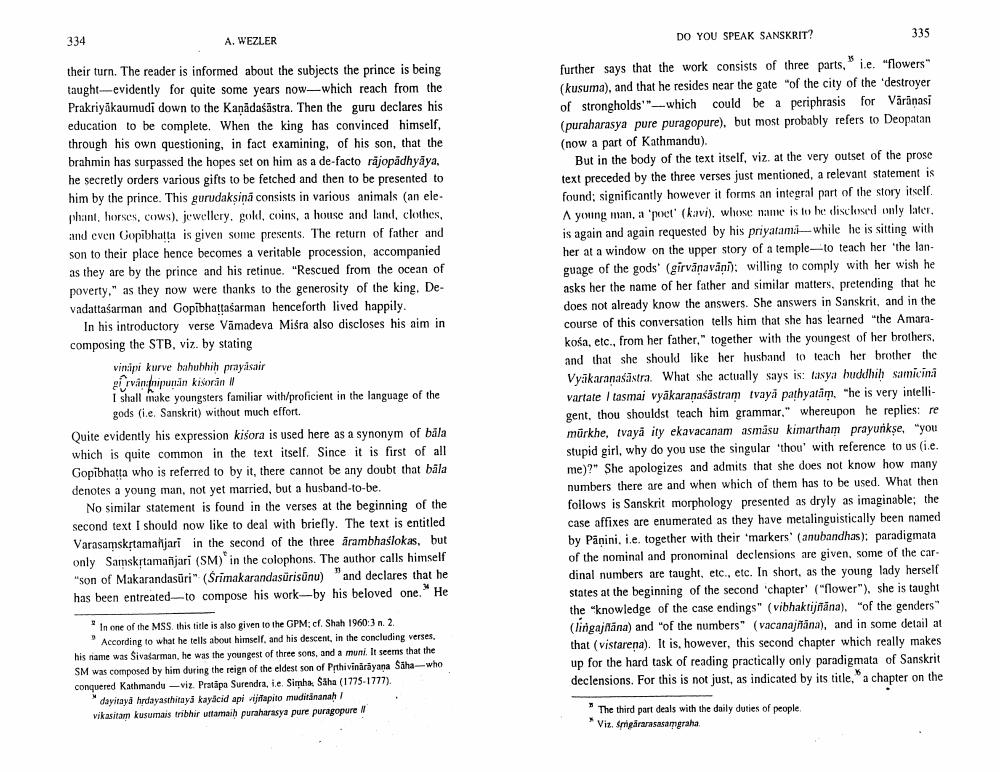________________
334
A. WEZLER
DO YOU SPEAK SANSKRIT?
335
their turn. The reader is informed about the subjects the prince is being taught-evidently for quite some years now—which reach from the Prakriyakaumudi down to the Kanādaśāstra. Then the guru declares his education to be complete. When the king has convinced himself, through his own questioning, in fact examining, of his son, that the brahmin has surpassed the hopes set on him as a de-facto rajopadhyāya. he secretly orders various gifts to be fetched and then to be presented to him by the prince. This gurudaksină consists in various animals an ele. phant, horses, cows), jewellery, goll, coins, a house and land, clothes, and even Gopibhatta is given some presents. The return of father and son to their place hence becomes a veritable procession, accompanied as they are by the prince and his retinue. "Rescued from the ocean of poverty," as they now were thanks to the generosity of the king. Devadattaśarman and Gopibhattašarman henceforth lived happily.
In his introductory verse Vāmadeva Misra also discloses his aim in composing the STB, viz. by stating
vinsipi kurve bahubhih prayisair girvantipunan kisorin I shall inake youngsters familiar with/proficient in the language of the
gods (ie. Sanskrit) without much effort. Quite evidently his expression kisora is used here as a synonym of bala which is quite common in the text itself. Since it is first of all Gopibhatta who is referred to by it, there cannot be any doubt that bala denotes a young man, not yet married, but a husband-to-be.
No similar statement is found in the verses at the beginning of the second text I should now like to deal with briefly. The text is entitled Varasamskrtama jari in the second of the three drambhaslokas, but only Samskrtamañjari (SM) in the colophons. The author calls himself "son of Makarandasüri" (Srimakarandasurisūnu) "and declares that he has been entreated to compose his work-by his beloved one. He
further says that the work consists of three parts, i.e. "flowers (kusuma), and that he resides near the gate of the city of the destroyer of strongholds" which could be a periphrasis for Värānasi (puraharasya pure puragopure), but most probably refers to Deopatan (now a part of Kathmandu).
But in the body of the text itself, viz. at the very outset of the prose text preceded by the three verses just mentioned, a relevant statement is found: significantly however it forms an integral part of the story itsell A young man, a poet' (kavi), whose name is to be disclosed only later, is again and again requested by his priyatam.. while he is sitting with her at a window on the upper story of a temple-to teach her "the language of the gods' (girvanavāni): willing to comply with her wish he asks her the name of her father and similar matters, pretending that he does not already know the answers. She answers in Sanskrit, and in the course of this conversation tells him that she has learned "the Amara. koša, etc., from her father, together with the youngest of her brothers, and that she should like her husband to teach her brother the Vyakaranasastra. What she actually says is: tasya buddhih samicini vartate / tasmai vyākaranaśāstram tvaya pathyatam, "he is very intelligent, thou shouldst teach him grammar," whereupon he replies: re mürkhe, tvaya ity ekavacanam asmäsu kimartham prayurkse, "you stupid girl, why do you use the singular thou' with reference to us (ie. me)?" She apologizes and admits that she does not know how many numbers there are and when which of them has to be used. What then follows is Sanskrit morphology presented as dryly as imaginable; the case affixes are enumerated as they have metalinguistically been named by Panini, i.e. together with their 'markers' (anubandhas); paradigmata of the nominal and pronominal declensions are given, some of the car dinal numbers are taught, etc., etc. In short, as the young lady herself states at the beginning of the second chapter" ("Power"), she is taught the "knowledge of the case endings" (vibhaktijnana), "of the genders" (lingajñāna) and of the numbers" (vacanajñāna), and in some detail at that (vistarena). It is, however, this second chapter which really makes up for the hard task of reading practically only paradigmata of Sanskrit declensions. For this is not just, as indicated by its title, a chapter on the
In one of the MSS. this title is also given to the GPM; cf. Shah 1960:
3 2 According to what he tells about himself, and his descent, in the concluding verses his name was Sivasarman, he was the youngest of three sons, and a muni. It seems that the SM was composed by him during the reign of the eldest son of Pithivinarayana Saha who conquered Kathmandu - viz. Pratapa Surendra, le Simha, Saha (1775-1777).
dayitayā hrdayasthitaya kayacid api vitapito muditananah vikasitam kusumais tribhir uttamaih puraharasya pure puragopure
The third part deals with the daily duties of people. Viz. Sigararasasamgraha




